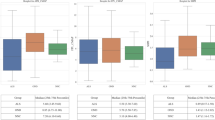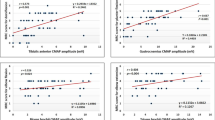Abstract
Split-hand phenomenon in amyotrophic lateral sclerosis (ALS) is characterized by uneven progression of muscle weakness in the intrinsic hand muscles, with predominant wasting of abductor pollicis brevis (APB) and first dorsal interosseus muscles over abductor digiti minimi (ADM) muscle. The aim of the study was to evaluate the split-hand phenomenon in ALS patients using motor unit index (MUNIX). Fifty-six patients diagnosed with definite and probable ALS according to El Escorial criteria were enrolled in the study. Twenty-seven patients (48.2%) had bulbar-onset ALS, while twenty-nine patients (51.8%) presented with spinal-onset ALS. Clinical measures including disease duration, disease stage according to the King’s College staging system, and ALSFRS-R score were evaluated for each patient. The control group consisted of twenty-two healthy subjects with normal findings on nerve conduction studies of the upper extremities. Both APB and ADM were studied, and ratios (APB/ADM) of the compound muscle action potential (CMAP) and MUNIX were assessed. Although CMAP and MUNIX ratios were lower in ALS than in healthy controls, this reached statistical significance only for the MUNIX ratio. No correlations were found between electrophysiological data (MUNIX and CMAP ratios) and clinical measures in the ALS group, which could be caused by high clinical heterogeneity in the ALS group. Our findings correspond to the literature data on high diagnostic sensitivity of MUNIX in assessing the split-hand phenomenon. MUNIX is a promising tool for evaluation of the split-hand phenomenon, which can be widely used both for analyzing mechanisms of disease pathology in longitudinal studies and improving early diagnosis of the disease.




Similar content being viewed by others
REFERENCES
Masrori, P. and van Damme, P., Amyotrophic lateral sclerosis: a clinical review, Eur. J. Neurol., 2020, vol. 27, no. 10, p. 1918.
Ludolph, A.C., et al., Pattern of paresis in ALS is consistent with the physiology of the corticomotoneuronal projections to different muscle groups, J. Neurol., Neurosurg. Psychiatry, 2020, vol. 91, no. 9, p. 991.
Wang, Z.-L., et al., A prospective study on split-hand index as a biomarker for the diagnosis of amyotrophic lateral sclerosis, Amyotrophic Lateral Scler. Frontotemporal Degener., 2020, vol. 21, nos. 7–8, p. 574.
Abraham, A., et al., Split-hand phenomenon in motor neuron diseases: sonographic assesment of muscle thickness, Clin. Neurophysiol., 2020, vol. 131, no. 8, p. 1721.
Wang, Z.-L., et al., Split-hand index in amyotrophic lateral sclerosis: an F-wave study, Amyotrophic Lateral Scler. Frontotemporal Degener., 2019, vol. 20, no. 7, p. 562.
Bostock, H., Jacobsen, A.B., and Tankisi, H., Motor unit number index and compound muscle action potential amplitude, Clin. Neurophysiol., 2019, vol. 130, no. 9, p. 1734.
Nandedkar, S.D., et al., Motor unit number index (MUNIX), IEEE Trans. Biomed. Eng., 2004, vol. 51, no. 12, p. 2209.
Huynh, W., et al., Functional biomarkers for amyotrophic lateral sclerosis, Front. Neurol., 2019, vol. 9, p. 1141.
Gunes, T., et al., Use of CMAP, MScan fit-MUNE, and MUNIX in understanding neurodegeneration pattern of ALS and detection of early motor neuron loss in daily practice, Neurosci. Lett., 2021, vol. 741, p. 135488.
Fatehi, F., et al., The utility of motor unit number index: a systematic review, Neurophysiol. Clin., 2018, vol. 48, no. 5, p. 251.
Swash, M., Reading the palm with MUNIX: a “reversed split hand” in spinal muscular atrophy, Clin. Neurophysiol., 2019, vol. 130, no. 2, p. 305.
Zheng, C., et al., Split-hand phenomenon quantified by the motor unit number index for distinguishing cervical spondylotic amyotrophy from amyotrophic lateral sclerosis, Neurophysiol. Clin., 2019, vol. 49, no. 5, p. 391.
Kim, D.G., et al., Split-hand phenomenon in amyotrophic lateral sclerosis: a motor unit number index study, Muscle Nerve, 2016, vol. 53, no. 6, p. 885.
Corcia, P., et al., Split-hand and split-limb phenomena in amyotrophic lateral sclerosis: pathophysiology, electrophysiology and clinical manifestations, J. Neurol., Neurosurg. Psychiatry, 2021, vol. 92, no. 10, p. 1126.
Swash, M., Reading the palm with MUNIX: A’reversed split hand’in spinal muscular atrophy, Clin. Neurophysiol., 2018, vol. 130, no. 2, p. 305.
Singh, R.-J., et al., Reverse split hand syndrome: dissociated intrinsic hand muscle atrophy pattern in Hirayama disease/brachial monomelic amyotrophy, Amyotrophic Lateral Scler. Frontotemporal Degener., 2017, vol. 18, nos. 1–2, p. 10.
Wang, Z.-L., et al., Split-hand syndrome in amyotrophic lateral sclerosis: differences in dysfunction of the FDI and ADM spinal motoneurons, Front. Neurosci., 2019, vol. 13, p. 371.
Weber, M., et al., The split hand in ALS has a cortical basis, J. Neurol. Sci., 2000, vol. 180, no. 1, p. 66.
Bae, J.S., et al., Cortical hyperexcitability and the split-hand plus phenomenon: pathophysiological insights in ALS, Amyotrophic Lateral Scler. Frontotemporal Degener., 2014, vol. 15, nos. 3–4, p. 250.
Menon, P., et al., Sensitivity and specificity of threshold tracking transcranial magnetic stimulation for diagnosis of amyotrophic lateral sclerosis: a prospective study, Lancet Neurol., 2015, vol. 14, no. 5, p. 478.
Menon, P., Kiernan, M.C., and Vucic, S., Cortical dysfunction underlies the development of the split-hand in amyotrophic lateral sclerosis, PLoS One, 2014, vol. 9, no. 1, p. e87124.
de Carvalho, M. and Swash, M., The split hand in amyotrophic lateral sclerosis: a possible role for the neuromuscular junction, Amyotrophic Lateral Scler. Frontotemporal Degener., 2019, vol. 20, nos. 5–6, p. 368.
Kim, D.G., et al., Split-hand phenomenon in amyotrophic lateral sclerosis: a motor unit number index study, Muscle Nerve, 2016, vol. 53, no. 6, p. 885.
Günther, R., et al., Motor Unit Number Index (MUNIX) of hand muscles is a disease biomarker for adult spinal muscular atrophy, Clin. Neurophysiol., 2019, vol. 130, no. 2, p. 315.
Zheng, C., et al., Split-hand phenomenon quantified by the motor unit number index for distinguishing cervical spondylotic amyotrophy from amyotrophic lateral sclerosis, Neurophysiol. Clin., 2019, vol. 49, no. 5, p. 391.
Author information
Authors and Affiliations
Corresponding author
Ethics declarations
The authors declare that there is no conflicts of interest.
Rights and permissions
About this article
Cite this article
Abramova, A.A., Broutian, A.G. & Zakharova, M.N. Exploring the Split-Hand Phenomenon in ALS with Motor unit Number Index (MUNIX). Hum Physiol 47, 854–860 (2021). https://doi.org/10.1134/S0362119721080016
Received:
Accepted:
Published:
Issue Date:
DOI: https://doi.org/10.1134/S0362119721080016




